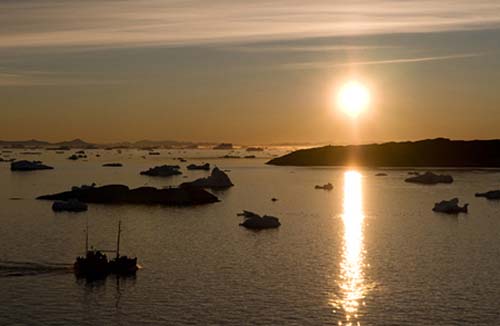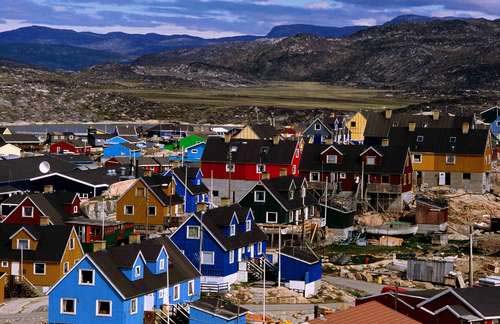Shocked because the sun rises early in the Arctic
People in a town in western Greenland Island fluttered as they watched the sun rise from the horizon on January 11, two days earlier than every year.

The sun rises in the middle of the night on Greenland. In many places in the Arctic, people often
live in summer scenes without nights or winters without days. ( Photo: whoi.edu )
Livescience said, Ilulissat town is located west of Greenland - the world's largest island and Denmark. It lies within the Arctic circle - the latitude line that surrounds the frozen area of the north pole of the earth. That location makes people in the town unable to see the light for a long time in the middle of winter. Usually they witness the first dawn on January 13 every year.
The news that Greenland people see the sun two days earlier than every year is posted in online newspapers in the UK and Germany.
Scientists make some hypotheses to explain this strange phenomenon. For example, some say it is an illusion caused by an atmospheric phenomenon . Many people think climate change plays a role. Due to the warming of the earth, part of Greenland's ice melted, making the world's largest island rise. The height of the island increases, making the distance between it and the sun decrease. The shorter the distance between the sun and the island, the earlier the sun appears.

A corner of Ilulissat town in western Greenland island. ( Photo: virtualtourist.com )
Why is the sun "missing" at Ilulissat in the middle of winter?
The sun rises and sets every day because the earth revolves around its axis. Every 24 hours the earth completes a revolution around the axis. The Earth's axis is 23.5 degrees Celsius and its rotation around the sun for 365 days leads to the existence of four seasons. The main Arctic circle is the latitude line 66 degrees North. It surrounds an area in which people do not see the sunrise on the solstice day (the top half of the earth is facing the sun and also the longest day of the year) and the winter solstice (the shortest day) in year).
The more you move away from the Arctic circle to the north end, the more time no nights in the summer or no winter days. Ilulissat town is located on the latitude 3 degrees North, so in the middle of winter, people here do not see sunlight.
At the North Pole, the sun only grows exactly once a year - in early spring. From that time to the winter solstice, the sun will rise higher every day. After the winter day, it fell again, but did not dive until the day of collection in late September.
- Interesting facts about animals living in the Arctic
- BBC reporter shocked when he saw UFOs with his eyes
- Shocked, snow foxes exceeded 3,500km in just 76 days
- Arctic sea ice area is at a record low
- Every second 14,000 tons of water flows into the sea because the Arctic ice melts
- The volume of ice in the Arctic drops to a record low
- The Arctic lost three times as much ice as Belgium every day
- The extraordinary journey of the Arctic fox
- Arctic ice is melting record fast
- Perennial ice in the Arctic is disappearing
- Volcano under the Arctic ice
- Ice in the Arctic is likely to disappear by 2030
 The truth about the mysterious red-haired giant at Lovelock Cave
The truth about the mysterious red-haired giant at Lovelock Cave Inunaki Tunnel: The haunted road leading into Japan's 'village of death'
Inunaki Tunnel: The haunted road leading into Japan's 'village of death' The mystery of the phenomenon of human reflection before dying
The mystery of the phenomenon of human reflection before dying 6 mysterious phenomena, although science has been developed for a long time, still cannot be answered
6 mysterious phenomena, although science has been developed for a long time, still cannot be answered